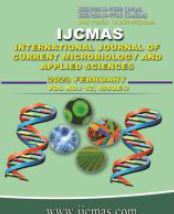


 National Academy of Agricultural Sciences (NAAS)
National Academy of Agricultural Sciences (NAAS)

|
PRINT ISSN : 2319-7692
Online ISSN : 2319-7706 Issues : 12 per year Publisher : Excellent Publishers Email : editorijcmas@gmail.com / submit@ijcmas.com Editor-in-chief: Dr.M.Prakash Index Copernicus ICV 2018: 95.39 NAAS RATING 2020: 5.38 |
Skin being the largest organ of our human body and Out of numerable immune preclusion mechanisms in our body skin is one of the momentous defence. For those patients who survive initial burn injury infection is an imperative issue. Burn wound injuries are one of the most common, invasive and devastating forms of trauma. Despite the recent advances in burn wound management, bacterial infections persist as an important complication and leading cause of morbidity and mortality among burnt patients. The leading issue in burns wound management is culpability of the burn wound to colonisation of bacteria. Disparity of bacterial flora isolated is appreciated during the period of wound healing. This descriptive study was performed in the department of Microbiology, in conjunction with the burns wards in a Tertiary care hospital. This study was conducted from 2022 October to 2022 December. Organisms are identified based on the morphology of the colonies, Gram stain appearance, testing for presence of catalase enzyme, testing for presence of oxidase enzyme, testing of motility by hanging drop method. Antibiotic susceptibility test was done using modified Kirby Bauer’s disc diffusion method on Mueller Hinton Agar as per Clinical and Laboratory Standards Institute Guidelines. Out of 100 patients, majority of them belongs to 21-40 years and female patients were 61%. Out of 100 samples processed, 67 sample showed bacterial growth and 43 sample showed no growth. Among the 67 sample with growth, gram negative isolates (68.6%) were more compared to gram positive isolates(31.3%). Klebsiella species (26.8%) were the most predominant organism isolated followed by Pseudomonas aeruginosa (16.4%), Proteus species (11.9%), Acinetobacter baumannii (8.9%), Escherichia coli (4.4%) among gram negative organisms. In the gram positive isolates, Staphylococcus aureus were (16.4%), followed by Coagulase negative Staphylococcus (10.4%), Enterococcus species (4.4%). Klebsiella is the most common isolate among all followed by Pseudomonas, Staphylococcus aureus. Piperacillin and tazobactam, carbapenem has increased sensitivity when compared to other drugs for Gram negative pathogens, where as Cotrimoxazole, Amoxycillin Clavulanic acid, Ciprofloxacin all have very high resistance.
 |
 |
 |
 |
 |